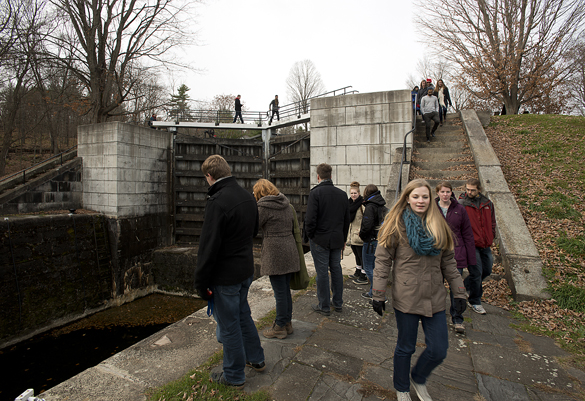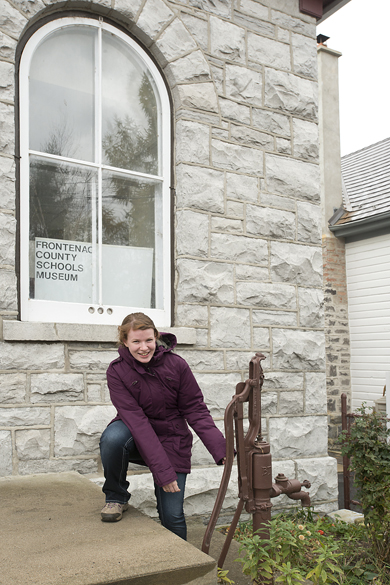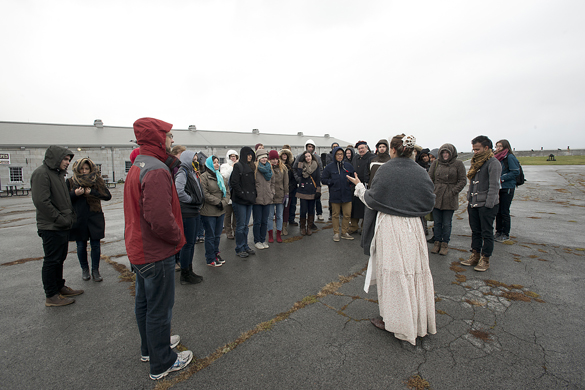Last Saturday, HTA students enjoyed a day-long bus trip that took us all the way to Kingston and back. Our leader was the inimitable Pierre du Prey, Professor Emeritus of Queen’s University, Adjunct Research Professor in HTA at Carleton, and one of the most distinguished architectural historians in the country.
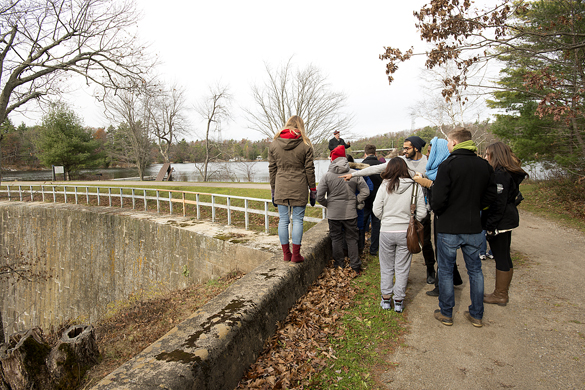
HTA students peer over the abyss at Jones Falls Dam, while their instructor clutches his release forms.
We began with a visit to what might be the mightiest example of 19th-century engineering in the country: the dam and locks at Jones Falls. The dam is a formidable curved wall of limestone – taking the form, as one of my students eagerly pointed out, of a segmental barrel vault built into the landscape. The locks themselves are downright spooky at this time of year – giant stone pits cut into the hillside, with no railings or barriers. I always have to get students to sign elaborate release forms before coming on these trips – this was the first time I was actually grateful for them.
From Jones Falls we headed to Barriefield Village, where the generous and welcoming Anglican Church Women provided us with a quite stunning lunch: four kinds of hot soup, more kinds of sandwiches than I could keep track of, and a mouth-watering collection of squares. Every drop, bite and crumb was home-made, and no one left hungry.
Barriefield itself is an almost miraculous survival of a 200-year-old village butted up against a rather larger city (Kingston). As Pierre du Prey (a Barriefield resident) explained to us, there was actually nothing ‘miraculous’ about the survival – it was an act of sheer stubborn will on the part of the residents, and current development pressures require continued vigilance on their part. Pierre gave us an expert tour of the village’s tiny lanes and exquisite stone houses, and one of the students remarked that she could hardly believe that such a place existed. We also had a good long look at the interior of St. Mark’s Church, where we were joined by historian William Patterson and conservator Alexander Gabov.
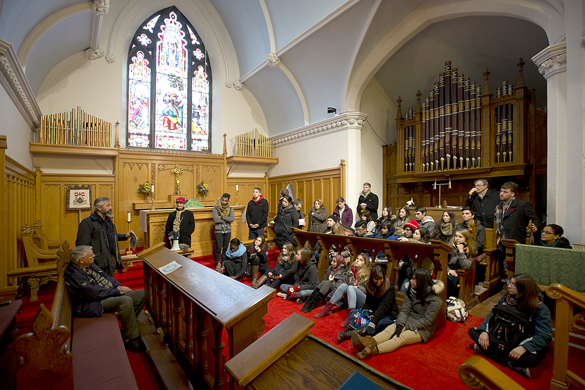
Historian William Patterson (seated at left) and conservator Alexander Gabov (standing at left) share their experiences and insights at St. Mark’s Barriefield.
Our day ended at Fort Henry, where the increasing cold, wind and rain gave us a bit more of an insight into the hardship of life as a British soldier in Kingston in the 1830s than we had bargained for. How our guide survived, dressed in flimsy period costume, I will never know.

Pierre laments the modern monstrosity down the hill (mercifully out of frame), as students look on aghast.
It was a grand day out in every way. I am so grateful to Pierre du Prey, a true scholar and teacher whose presence in the classroom is sorely missed at Queen’s (but happily still enjoyed on a regular basis at Carleton). I am also grateful to my School Director, William Echard, and my Dean, John Osborne, whose generous support made it possible to offer this trip to our students free of charge. And, I am grateful to the students who came, for their enthusiasm and engagement. It really takes an enormous amount of time, energy, hard work and good will to make events like this happen, but we seem to be blessed with an abundance of these in HTA – or at least, an abundance of the last three!

